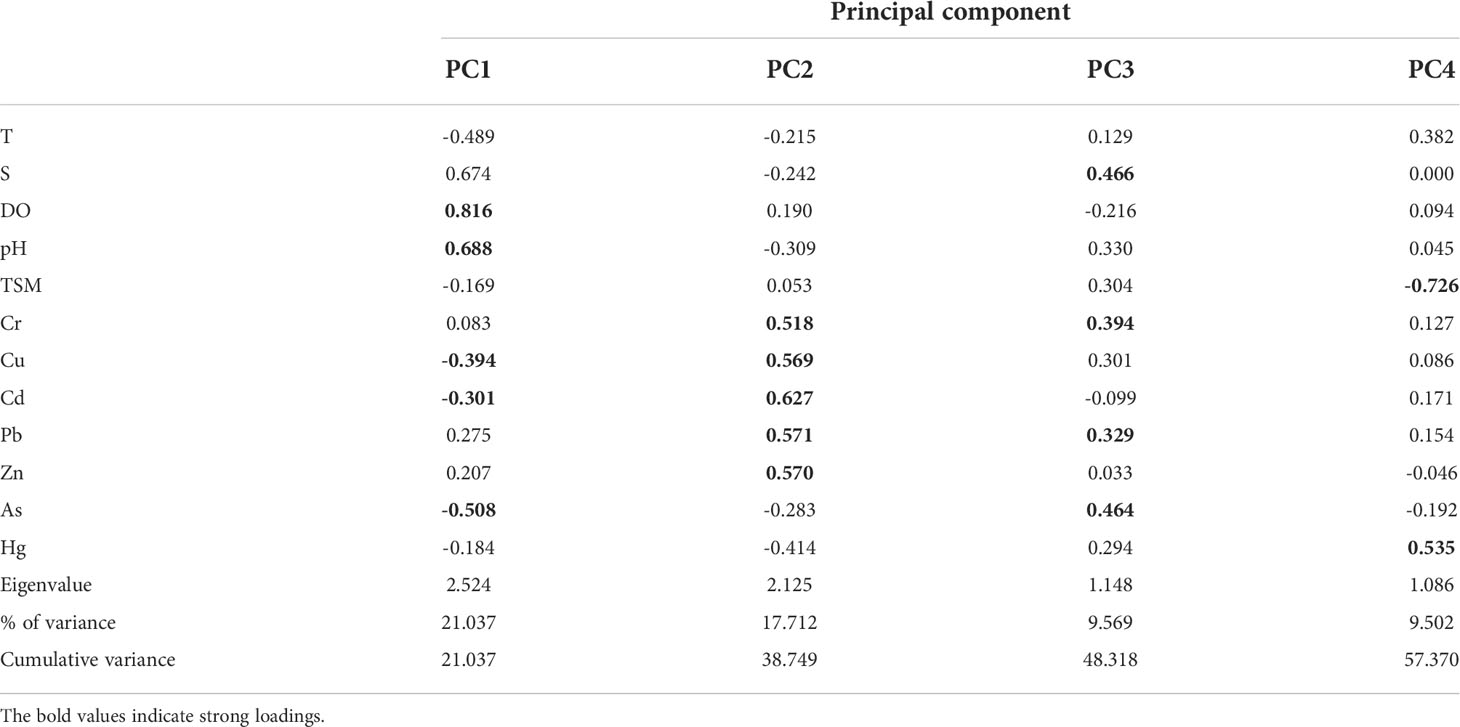- 1Guangxi Key Laboratory of Beibu Gulf Marine Resources, Environment and Sustainable Development, Fourth Institute of Oceanography, Ministry of Natural Resources, Beihai, China
- 2Key Laboratory of Tropical Marine Ecosystem and Bioresource, Fourth Institute of Oceanography, Ministry of Natural Resources, Beihai, China
Heavy metal contaminations in the marine environment are of considerable attention because of their high potential ecological effects and public concern for human health. However, the influencing factors for the large-scale distributions of heavy metals in Beibu Gulf, a newly developing industry and port in South China, are still unclear due to the lack of large-scale investigation. Here, a total of 871 samples in the 127 stations in the seawater of Beibu Gulf during spring, summer, fall and winter in 2020-2021 were analyzed for dissolved heavy metal concentrations and physicochemical parameters. The concentrations of heavy metals in the Beibu Gulf ranked following the order of Zn > Cu > Cr > As > Pb > Hg > Cd. Compared to other regions, the concentrations of Hg were at relatively higher levels, which were mainly influenced by the input of the transportation of water masses from the local and other regions; whereas the other heavy metals were at relatively lower levels. Seasonally variations in the concentrations of heavy metals were observed in the gulf, which is mainly influenced by human activities (i.e., shipping and mariculture activities) and seasonally hydrological conditions. Seasonal changes in the spatial distribution of heavy metals have been found in the gulf. The higher concentrations of heavy metals mainly occurred in the coastal bays or areas in summer whereas the higher concentrations were observed in the offshore areas during the other three seasons. This is mainly related to the seasonal changes of the water masses that affect the seawater of Beibu Gulf, which exhibits the dominant contribution of coastal current from the northern Beibu Gulf in summer, and the dominant contribution of west-Guangdong coastal current and SCS water during the other three seasons. The potential ecological risk index revealed that Hg is the main ecological risk factor in the gulf, and the heavy metal contamination in the gulf seems to be noticeable. This study highlights the seasonal changes of the water masses that affect the seawater of Beibu Gulf greatly affecting the large-scale distributions of heavy metals in the gulf.
Introduction
Since the 1950s, public hazard caused by heavy metal pollution, such as the mercury-caused Minamata disease in Japan and the occurrence of the cadmium Itaiitai disease, has been of great concern due to their persistence, high toxicity, non-degradability, and vast sources (Wang et al., 2013). Particularly in the marine environment, with the rapid economic and social development, large quantities of anthropogenic sources of heavy metals are discharged into the coastal environment, and those metals can be bioaccumulated by the marine organisms and biomagnified through the food chain, and ultimately endanger human health (Rainbow and Luoma, 2011; Kumar et al., 2019; Lao et al., 2019a; Liu et al., 2020; Huang et al., 2021). Thus, a better understanding of the current status of heavy metal contamination in marine ecosystems has a significant implication for the sustainable development of marine ecosystems, the seafood industry, and public concerns (Wang et al., 2013; Zhu and Zheng, 2017a; Zhu and Zheng, 2017b; Zhu and Zheng, 2018; Liu et al., 2020; Lao et al., 2022a).
Many researches have been increasingly concerned about the heavy metals in the marine environment. For example, increasing anthropogenic inputs of heavy metals into the seawater of mariculture areas have been reported due to the continuous expansion of the mariculture scale for the past decades (Wang et al., 2019; Liu et al., 2020; Lao et al., 2022a; Mohsen et al., 2022). Moreover, the coastal currents play an important role on the distribution of materials, and greatly impact on the local marine environment (Dong et al., 2012; Li et al., 2018; Lv et al., 2021; Hu et al., 2022; Lao et al., 2022b; Lao et al., 2022c). Once the heavy metals input into the seawater, they can transport along with ocean currents to other areas, resulting in the wide spread of heavy metals in the marine environment (Li et al., 2018). Environmental change, such as ocean acidification and seasonal hypoxia, could change heavy metal status in the marine environment (Atkinson et al., 2007; Chakraborty et al., 2016; Ma et al., 2016; Lao et al., 2019a; Lao et al., 2022a). For example, the decrease of pH value in the marine environment leads to the re-release of heavy metals from sediments into the overlying water with linkage variation of metal concentrations in seawater and sediment environment, resulting in the decrease of heavy metals in sediments and the increase in seawater (Lao et al., 2022a).
Beibu Gulf, located in the northwestern South China Sea (SCS), is a newly developing industry and port in South China (Lao et al., 2021a). Additionally, the gulf is an important mariculture base and one of the most important fishing grounds in China because of its high productivity and rich biological diversity (Liu et al., 2020; Xu et al., 2020; Xu et al., 2021; Chen et al., 2022a). This is mainly because there is a stable external nutrient input to the Beibu Gulf from different water masses to maintain marine production (Lao et al., 2021b; Lao et al., 2022c). However, the ecosystems of the Beibu Gulf, particularly in the northern coastal bays, are now facing many environmental issues (Kaiser et al., 2016; Lao et al., 2019a; Lao et al., 2021a; Lao et al., 2021b; Zhang et al., 2021a; Cai et al., 2022; Chen et al., 2022a), such as the aggravating seawater acidification (Lao et al., 2022a) and eutrophication over the past years due to intensive human activities (Lao et al., 2021b; Cai et al., 2022). In addition, heavy metal contaminations have also been widely reported in coastal areas or bays around the northern Beibu Gulf. For example, the contamination of heavy metals and other pollutants in both seawater and sediment showed an increasing trend in the northern coastal bays over the past decades (Chen et al., 2018; Lao et al., 2019a; Liu et al., 2020; Zhu et al., 2021; Zhang et al., 2021b; Lao et al., 2022a; Zhang et al., 2022a), which also increased the proportions of bioavailable metals in the environment of the gulf (Kang et al., 2017; Chen et al., 2022a). Moreover, the heavy metals in the coastal wetland sediment cores of the northern Beibu Gulf also exhibited an increasing trend from 1985 to 2008 (Gan et al., 2013). The pH value in the seawater decreased by 4.7% over the past two decades, which greatly impacts the distribution of heavy metals in the seawater and sediment (Lao et al., 2022a). According to the assessment of potential ecological risk index (ERI) (Hakanson, 1980), Hg is the dominant risk factor in the coastal bays of northern Beibu Gulf due to intensive human activities, such as mariculture, agricultural, shipping and industrial activities (Lao et al., 2019; Liu et al., 2020; Lao et al., 2022a). In addition, there are several water masses, namely the coastal current, SCS water, and West-Guangdong coastal current that affecting the seawater in the Beibu Gulf (Figure 1) (Lao et al., 2022c). These water masses will input rich materials into the Beibu Gulf (Chen et al., 2019; Lin et al., 2020; Lao et al., 2022c). Particularly the West-Guangdong coastal current, which originated from the diluted Pearl River and flows along the western coast of Guangdong Province with high contaminants into the Beibu Gulf through the Qiongzhou Strait (Chen et al., 2019; Lao et al., 2019b; Lin et al., 2020; Lao et al., 2022b; Lao et al., 2022c). However, the study on heavy metals in the Beibu Gulf is mainly on the nearshore or the coastal bays (Xia et al., 2011; Zhu and Zheng, 2013; Gu et al., 2015; Yang et al., 2015; Lao et al., 2019a; Liu et al., 2020; Yang et al., 2020; Lin et al., 2021; Lao et al., 2022a), and the characteristics of large-scale heavy metal contamination and distribution in the Beibu Gulf are still unclear. We speculate that the seasonal changes in water mass transportation in the Beibu Gulf (Lao et al., 2022c) may have a great impact on the local heavy metal contaminations and distributions.
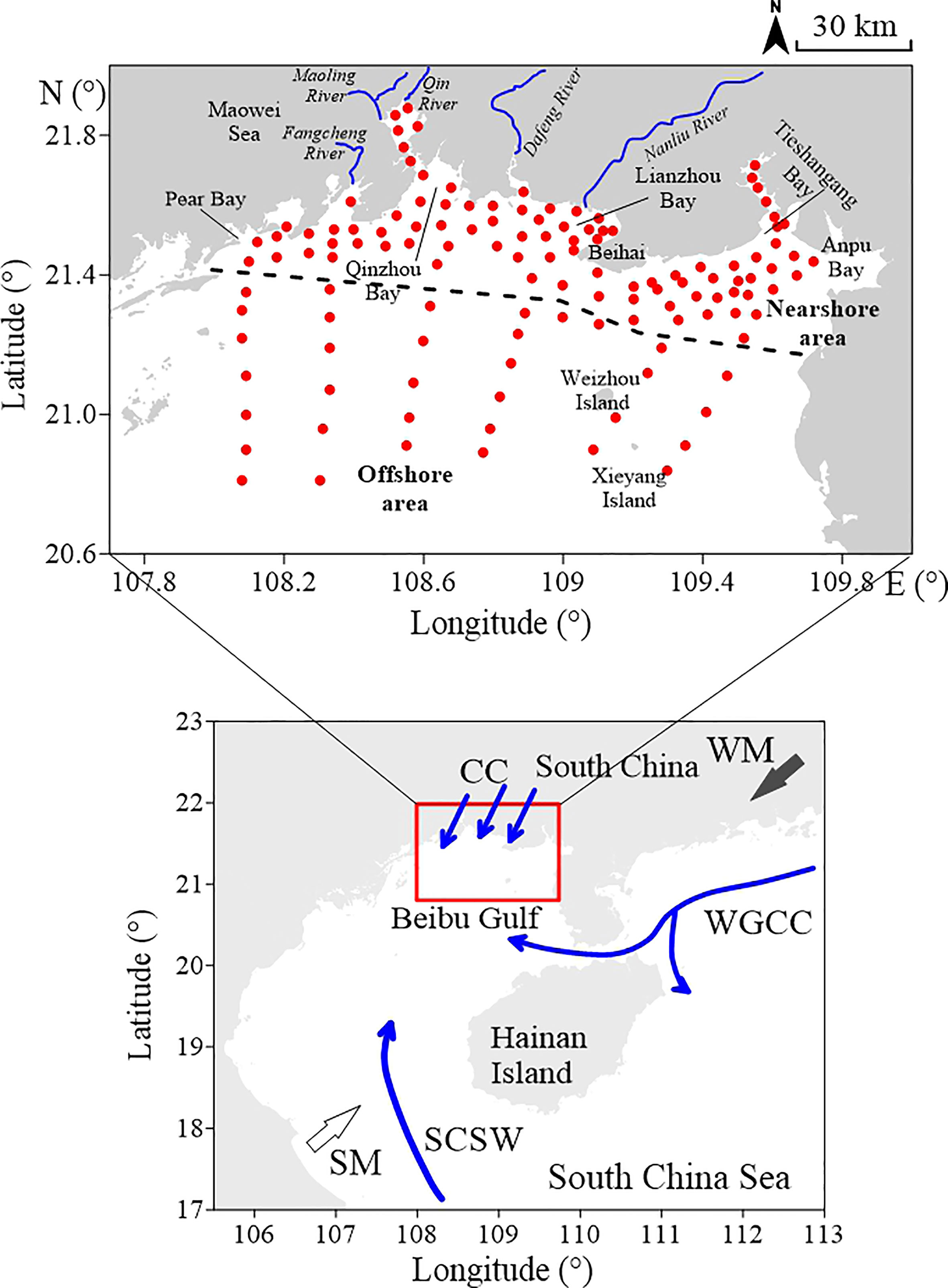
Figure 1 The study area and sampling sites (red blots) in Beibu Gulf. The dotted line is the dividing line between the nearshore and offshore area in the study area; the blue arrows in the below figure represent the water masses that affect the water in the gulf, which is modified from Lao et al. (2022c). WGCC, West-Guangdong coastal current; SCSW, South China Sea water; CC, coastal current from the Guangxi Province. The black and white arrows represent monsoons, SM, summer monsoon; WM, winter monsoon.
In this study, seasonal concentrations of seven heavy metals (Cu, Cd, Pb, Zn, As, Hg and Cr) and other physicochemical parameters in seawater in the large-scale Beibu Gulf were investigated to (1) analyze the seasonal distributions of heavy metals and their relationship with other related environmental parameters, (2) reveal the impact of seasonal intrusion of different water masses on the distribution of heavy metals and the possible behaviors and transition processes of those heavy metals in the gulf.
Materials and methods
Study area and sampling
The Beibu Gulf is a semi-enclosed bay with an average depth of 42 m and an area of about 130,000 km2 located in the northwestern SCS. The gulf is surrounded by the coast of Guangxi Province in the north, Vietnam in the west, the Leizhou Peninsula in the east, and Hainan Island in the southeast (Figure 1). The west-Guangdong coastal current originates from the diluted Pearl River and flows along the coast of western Guangdong Province. After reaching the coastal area on the east side of Leizhou Peninsula, a tributary of the current enters into Beibu Gulf through Qiongzhou Strait. In addition, many rivers flow from the coast of Guangxi Province in the north into the northern coastal bays (e.g. Qinzhou Bay, Lianzhou Bay), with the higher runoff of the rivers in the rainy seasons (132.51 × 108 m3) whereas lower runoff in the dry seasons (20.39 × 108 m3) (Lao et al., 2020; Lao et al., 2022c). The runoff in the northern Beibu Gulf formed a coastal current that affects the seawater in the gulf, which become the dominant contributor to the seawater of the gulf in the rainy season (43% in summer and 45% in fall) due to the high runoff in the northern gulf during these periods (Lao et al., 2020; Lao et al., 2022c), while the dominant contributor to the seawater of the gulf changed to the intrusion of SCS water (57%) with high salinity through the coast of western Hainan Island during the dry season (winter) due to sharp drop of runoff (Lao et al., 2020; Lao et al., 2022c). However, the contribution of the west-Guangdong coastal current to the seawater of Beibu Gulf was relatively stable throughout the year (24-31%) (Lao et al., 2022c). Beibu Gulf is influenced by the East Asian monsoon, with the southwestern monsoons prevailing in summer and the northeastern monsoons prevailing in winter. The annual rainfall in the gulf is 1775 mm, with the dominant precipitation in the rainy season (April-October, 1579 mm) due to a large amount of rainfall brought by frequent typhoons and high rainfall frequency during this period (Chen et al., 2021; Luo et al., 2022). In this study, the study area is covering all northern Beibu Gulf, including the coastal bays in the north and the offshore area extending to the central gulf (Figure 1).
Four cruises were conducted during summer (July 2020), fall (September 2020), winter (January 2021), and spring (May 2021) in the Beibu Gulf. A total of 127 stations were set up in each season. Only surface water was collected when the depth is less than 10 m, and surface and bottom water were collected when the depth is greater than 10 m. A total of 217, 221, 215, and 208 seawater samples were collected using a rosette sampler fitted with 10 L Niskin bottles (Acid cleaned using 25% trace metal grade HNO3) during spring, summer, fall, and winter, respectively. The profiles of salinity, temperature, and depth were determined using a calibrated Sea-Bird 911/19 plus CTD unit (USA). The seawater samples for total suspended particulate matter (TSM) were filtered by pre-weighed mix cellulose membranes (47 mm diameter and 0.45 μm pore size). The dissolved oxygen (DO) and pH were measured on-site using a calibrated multi-parameter water quality analyzer (Proplus, YSI, USA). The seawater samples for heavy metals were filtered using acid-cleaned cellulose acetate filters (47 mm diameter and 0.45 μm pore size, Entegris, China), and the filtrate was transferred into an acid-cleaned polyethylene bottle (250 mL), and then added HNO3 (Trace metal grade, CNW, Germany) to the filtrate to achieve a pH<2. The filtrate of the heavy metal sample was stored at -20°C until analysis.
Sample analysis
The seawater samples for the analysis of Cu, Pb, Zn, Cd, and Cr concentrations were diluted 20-fold using 2% HNO3 and then determined using an inductively coupled plasma mass spectrometer (ICPMS, ThermoFisher iCAP RQ, Bremen, Germany) by external calibration method. The samples for the analysis of As were pretreated with HCl (Trace metal grade, CNW, Germany) and thiourea-anticyclic acid (GR, Sinopharm, China) reducing agent for 30min. The samples for Hg were digested with sulfuric acid potassium persulfate (GR, Sinopharm, China) for 24 hours and then added with hydroxylamine hydrochloride (GR, Sinopharm, China) solution. The concentrations of As and Hg were determined using an atomic fluorescence spectrophotometer (AFS, Haiguang HGF-V2, Beijing, China) by an external calibration method. The method detection limits (Detailed in the supplementary materials) of Cr, Cu, Pb, Zn, Cd, Hg and As were 0.004 μg L-1, 0.003 μg L-1, 0.008 μg L-1, 0.005 μg L-1 and 0.001 μg L-1, 0.001 μg L-1, 0.01 μg L-1, respectively.
Quality control
Milli-Q water and trace metal-grade ultra-pure acids were used throughout the analysis. All labware was soaked with nitric acid (25%) for 7d and then cleaned with Milli-Q water before use. Procedure blanks were prepared by filtrating Milli-Q water and acidified to pH< 2 during the cruises. To ensure high precision and accuracy, blanks, duplicate samples, and certified reference materials (CRMs) were prepared with each batch of test samples (20 samples a batch). Seawater trace metal CRM GBW(E)080040 (For Cr, Cu, Pb, Zn, Cd, Second Institute of Oceanography, Ministry of Natural Resources, Hangzhou, China) was used for ICPMS analysis validation, CRM GBW(E)080042 (For Hg, Second Institute of Oceanography, Ministry of Natural Resources, Hangzhou, China) and CASS-5 (For As, National Research Council Canada, Ottawa, Canada) was used for AFS analysis validation. The relative standard deviation (RSD) of the determination methods was< 6%, and the recoveries were ± 10%, further analytical figures of merit were detailed in the supplementary materials. The metal concentrations were all blank-corrected in this study.
Heavy metal pollution assessment
The ERI proposed by Hakanson (1980) was used to conduct the risk assessment of heavy metal pollution in seawater of the Beibu Gulf. This method not only takes into account the heavy metal pollution coefficient obtained by the single factor pollution index method, but also introduces the toxicological response coefficient of heavy metals. The calculation formula of the ERI is as follows:
where Ci and Co denote the measured value of a heavy metal element in seawater (both surface and bottom water samples) and a standard value, denotes toxic response factor (TRF), denotes each metal potential ERI. In this study, Co obtained from the National Standard of China for Seawater Quality GB 3097-1997, Grades I, and of Hg, As, Cr, Cu, Pb, Zn, and Cd were 40, 10, 2, 5, 5, 1, and 30 (Liu et al., 2020; Lao et al., 2022a). To assess the potential ecological risk, the ERI could be classified into five grades (Table 1) (Liu et al., 2020; Lao et al., 2022a).
Statistical analysis
The data in this study were statistically analyzed by the IBM SPSS Statistics (Version 19.0). The spatial distributions of heavy metals were formed using Ocean Data View (Version 4.0). The analysis of Student’s t-test of the difference between the parameters in the two groups were performed using the IBM SPSS Statistics (Version 19.0). The correlations analysis and principal component analysis (PCA) between metals and other environmental factors were also performed by the IBM SPSS Statistics (Version 19.0). Notably, One-way ANOVA was carried out to verify whether the data had homogeneous variances (F-test) before the application of Student’s t-test.
Results
Physicochemical parameters in the Beibu Gulf
The physicochemical parameters in the seawater during the four seasons were illustrated in Figure 2. The temperature ranged from 12.70 to 33.70 °C. The salinity varied greatly in the gulf, and the values ranged from 2.20 to 34.21, with higher salinity in the dry seasons (winter (an average of 31.00) > fall (an average of 29.94), t-test, p< 0.001) and lower salinity in the rainy seasons (spring (an average of 27.56) > summer (an average of 26.94), t-test, p< 0.01) (Figure 2). The DO levels ranged from 3.40 to 10.30 mg L-1, with a decreased level of winter > fall > spring > summer (t-test, all p< 0.001). The pH values ranged from 7.46 to 8.90. The concentrations of TSM varied greatly with seasons, and the concentrations ranged from 0.01 to 99.32 mg L-1, with a decreased concentration of fall > summer > winter > spring (t-test, all p< 0.001).
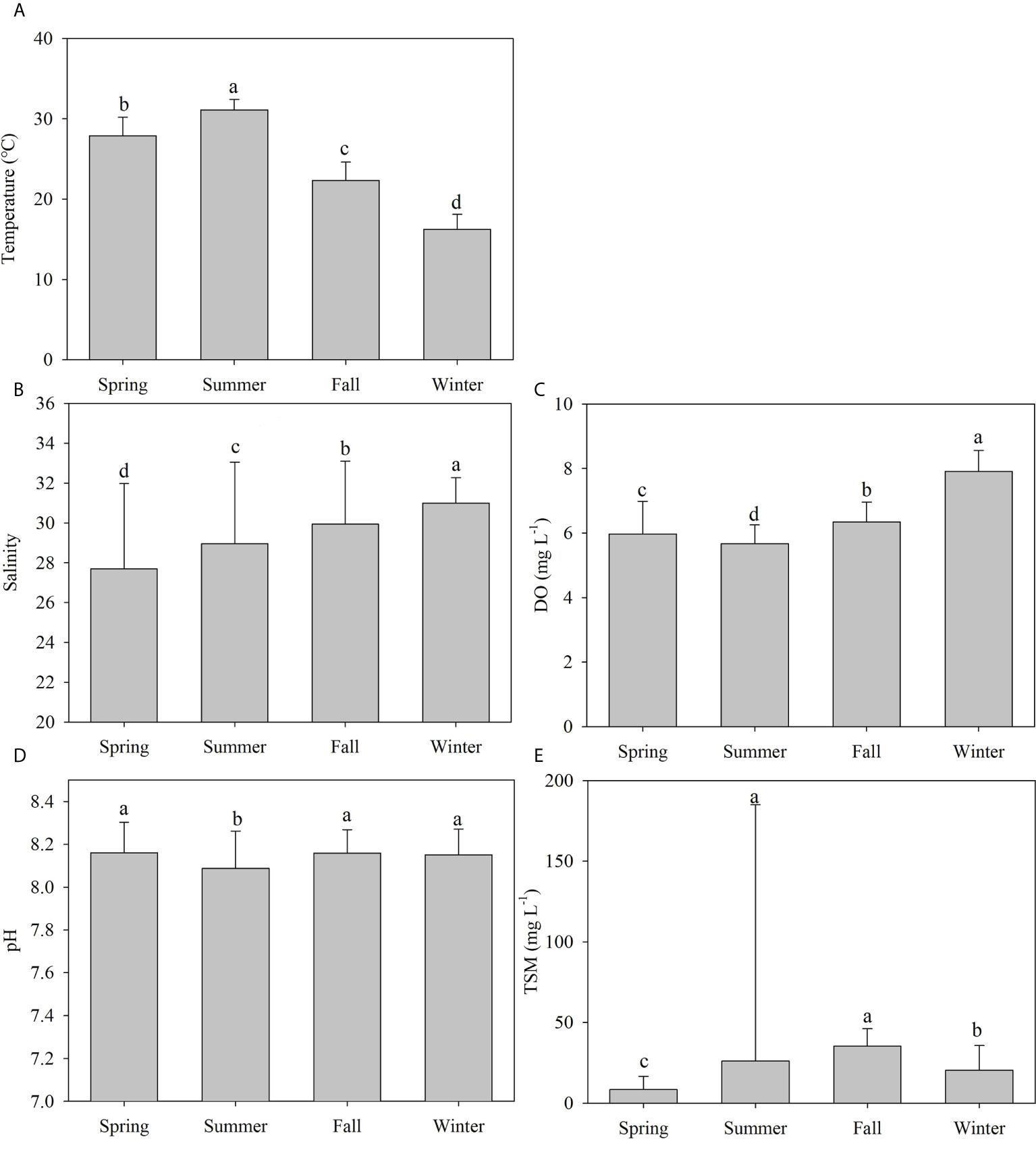
Figure 2 Seasonal variations of physicochemical parameters in the seawater of Beibu Gulf. The same letters in the bar chart denote significant differences; different letters in the bar chart denote significant differences. (A) Temperature; (B) Salinity; (C) DO; (D) pH; (E) TSM.
Heavy metals in the seawater of Beibu Gulf
The concentrations of the seven heavy metals in the Beibu Gulf during the four seasons were presented in Table 2. The seasonal variations of heavy metals in Beibu Gulf were presented in Figure 3. The concentrations of Cr, Cu, Cd, Pb, Zn, As, and Hg in the whole Beibu Gulf (both surface and bottom water) during the four seasons ranged from not detected (ND) to 6.81 μg L-1, ND to 7.74 μg L-1, ND to 0.26 μg L-1, ND to 5.77 μg L-1, ND to 74.87 μg L-1, ND to 1.18 μg L-1 and ND to 0.36 μg L-1, respectively, which ranked following the order of Zn (12.12 μg L-1) > Cu (1.06 μg L-1) > Cr (0.65 μg L-1) > As (0.62 μg L-1) > Pb (0.23 μg L-1) > Hg (0.08 μg L-1) > Cd (0.03 μg L-1). The seasonal variations of heavy metals are quite different in the gulf (Figure 3 and Table 2). Generally, the concentrations of Cr, Cd, Zn in winter and spring were significantly higher than that in summer (t-test, all p< 0.001) and fall (t-test, all p< 0.001). By contrast, concentrations of Cu, As and Hg in summer were significantly higher than that in the other three seasons (t-test, all p< 0.05). The concentrations of Pb in winter were significantly higher than in other seasons (t-test, all p< 0.001). The seasonal variation of different heavy metal concentrations indicates that their sources and factors affecting their distribution could be different. Spatially, the higher concentrations of Cu in summer were observed in the northern coastal bays (t-test, all p< 0.01) (Figure 4B), whereas the higher concentrations in other seasons were observed in the offshore areas (t-test, all p< 0.01). The higher concentrations of Pb were observed in the offshore areas during fall (t-test, p< 0.001) (Figure 4G) and winter (t-test, p< 0.01) (Figure 4F). However, the concentrations of Pb were lower in the gulf during spring and summer (t-test, all p< 0.01) except for a higher concentration in Weizhou Island during spring and in the nearshore of the central gulf during summer (Figures 4E, F). The higher concentrations of Zn were all observed in the offshore area during spring (t-test, p< 0.01), fall (t-test, p< 0.01) and winter (t-test, p< 0.01), while the higher concentrations were observed in the nearshore during summer (t-test, p< 0.001) (Figures 5A–D). The higher concentrations of Cd were generally observed in the nearshore areas during the four seasons (t-test, all p< 0.05) (Figures 5E–H). Significantly higher concentrations of Hg occurred in the offshore areas during summer (t-test, p< 0.001) (Figure 6B), whereas slightly higher concentrations occurred in the coastal bays during fall (t-test, p< 0.01) (Figure 6C). The higher concentrations of As during spring, summer, and fall were all observed in Tieshangang Bay and Lianzhou bay (Figure 6), whereas the higher concentrations were observed in the offshore areas during winter (t-test, p< 0.001) (Figure 6H). The concentrations of Cr were generally lower in the coastal bays during the four seasons, whereas higher concentrations occurred in the offshore areas, particularly in the fall (t-test, p< 0.001) and winter (t-test, p< 0.001) (Figure 7).
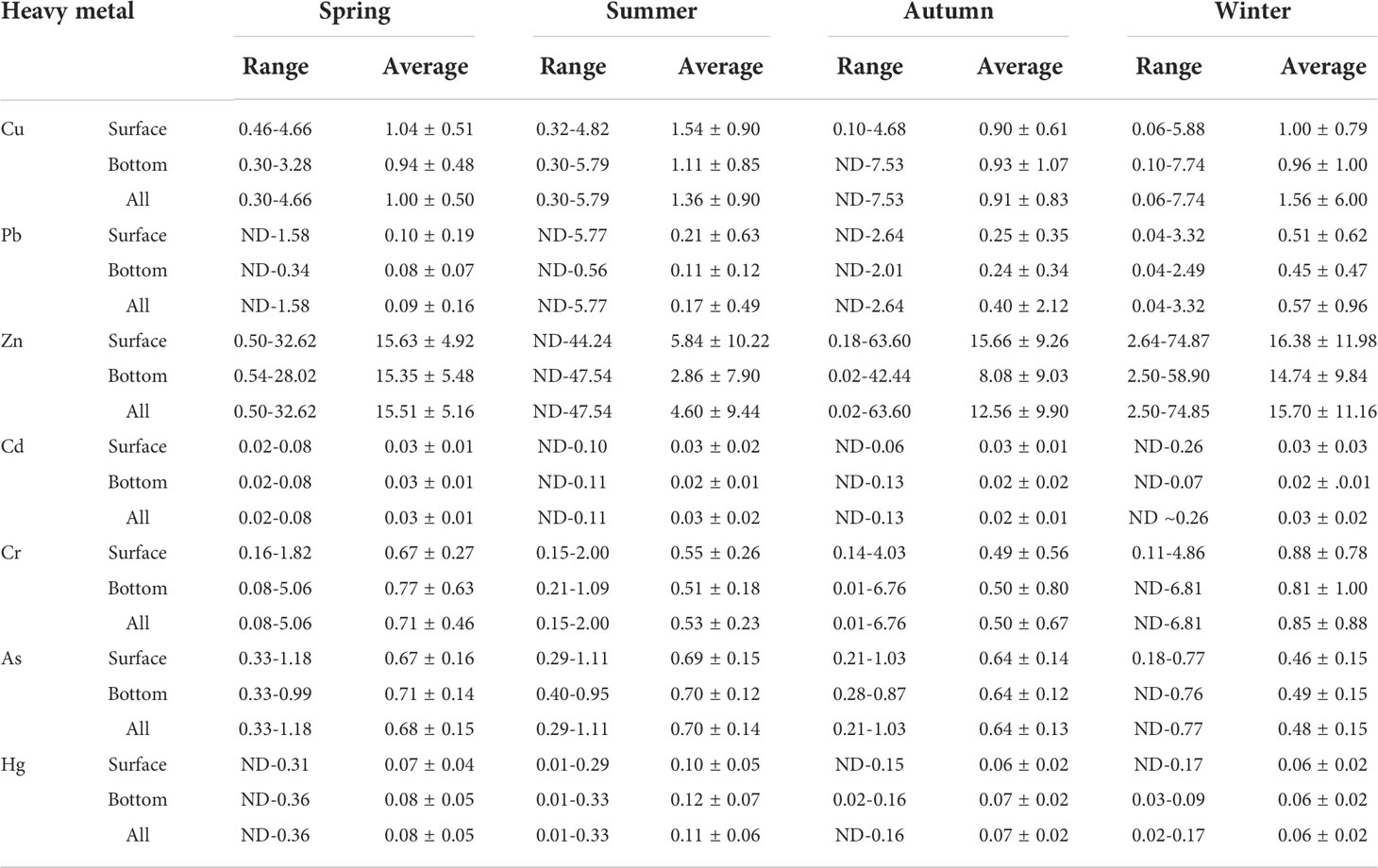
Table 2 Concentrations of heavy metals in seawater of the Beibu Gulf during different seasons (μg L-1).
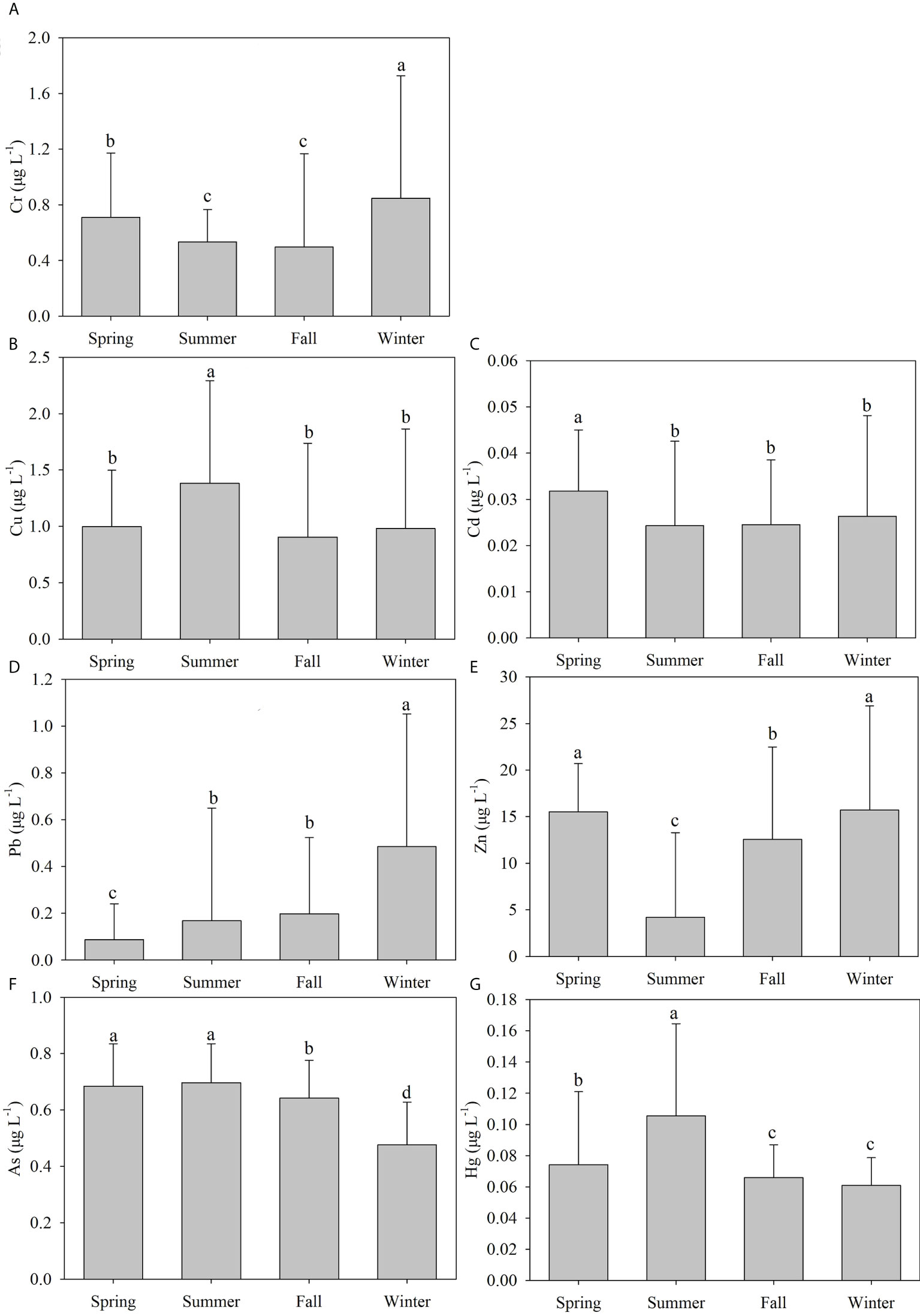
Figure 3 Seasonal variations of heavy metals in the seawater (including both surface and bottom) of Beibu Gulf. The same letters in the bar chart denote significant differences; different letters in the bar chart denote significant differences. (A) Cr; (B) Cu; (C) Cd; (D) Pb; (E) Zn; (F) As; (G) Hg.
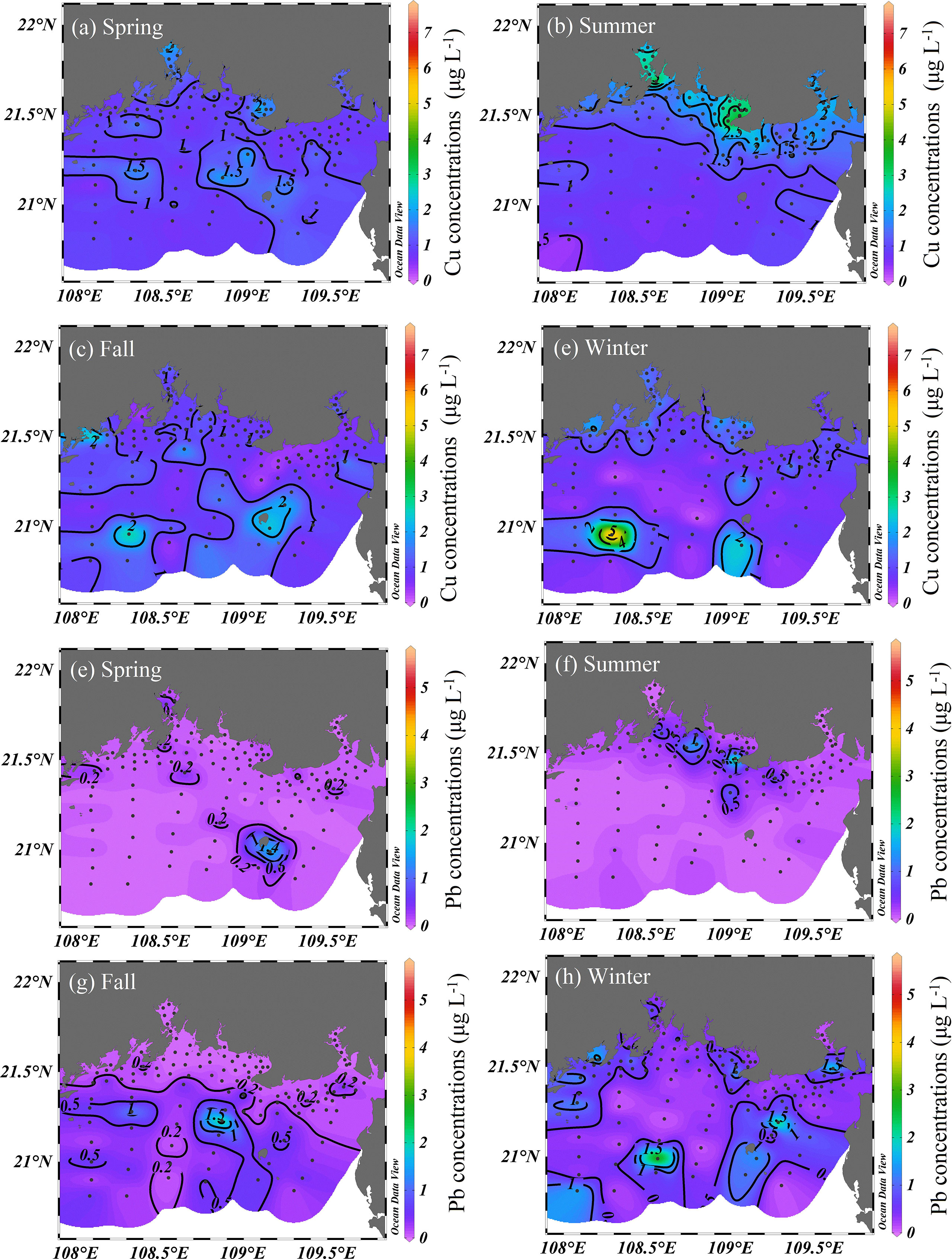
Figure 4 Spatial distributions of Cu and Pb in the surface seawater of Beibu Gulf during the sampling periods. (A) Cu-Spring; (B) Cu-Summer; (C) Cu-Fall; (D) Cu-Winter; (E) Pb-Spring; (F) Pb-Summer; (G) Pb-Fall; (H)-Pb-Winter.
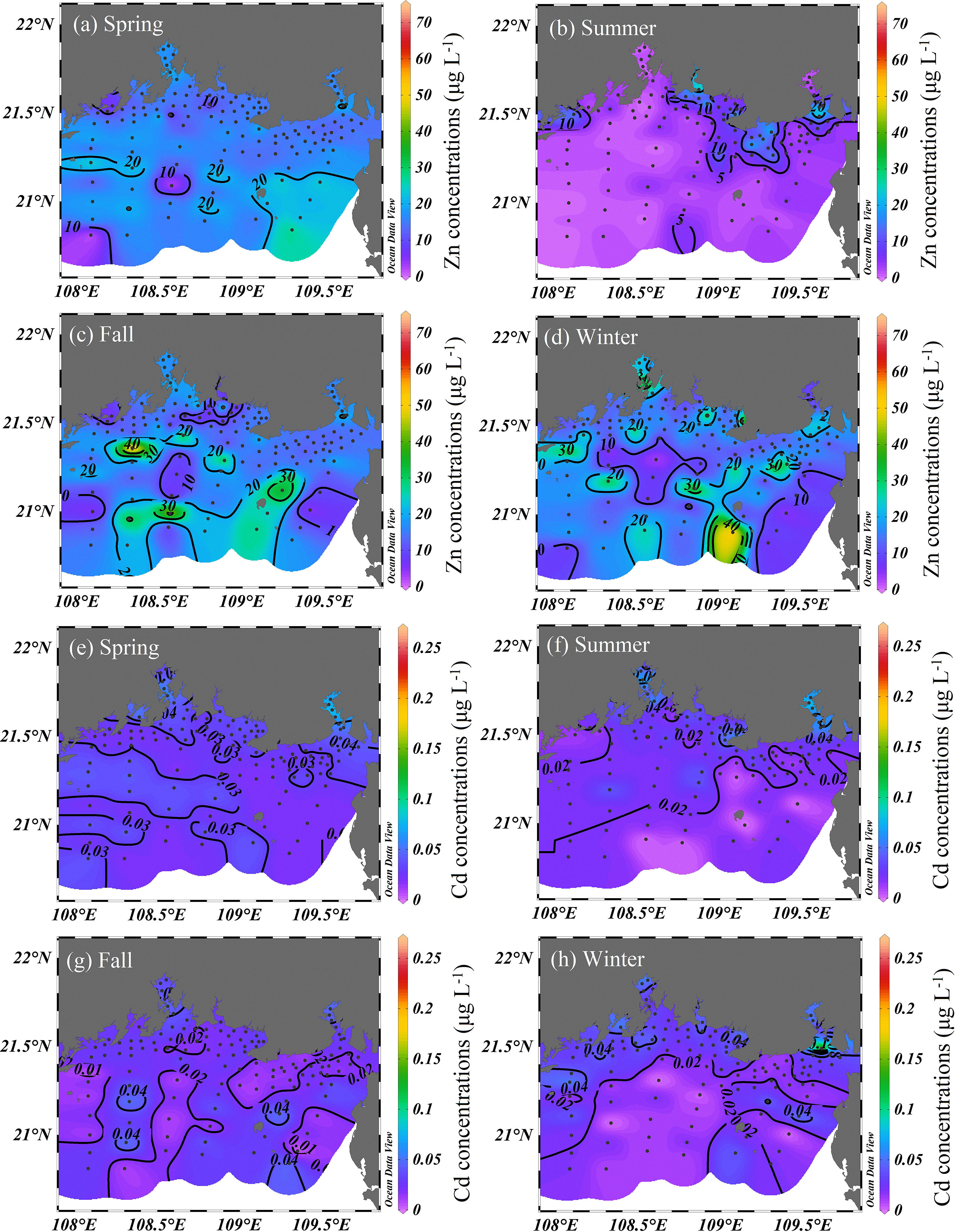
Figure 5 Spatial distributions of Zn and Cd in the surface seawater of Beibu Gulf during the sampling periods. (A) Zn-Spring; (B) Zn-Summer; (C) Zn-Fall; (D) Zn-Winter; (E) Cd-Spring; (F) Cd-Summer; (G) Cd-Fall; (H) Cd-Winter.
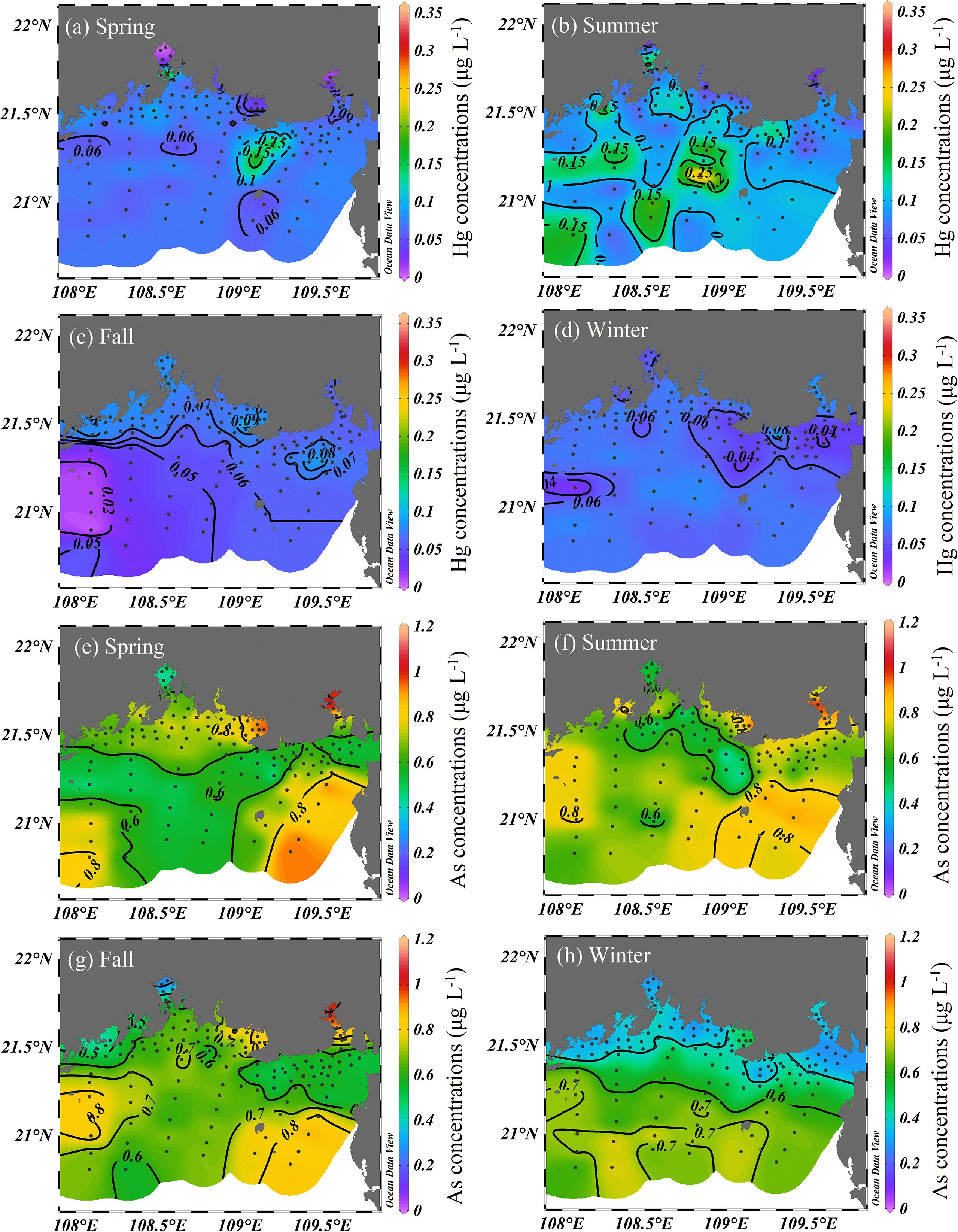
Figure 6 Spatial distributions of Hg and As in the surface seawater of Beibu Gulf during the sampling periods. (A) Hg-Spring; (B) Hg-Summer; (C) Hg-Fall; (D) Hg-Winter; (E) As-Spring; (F) As-Summer; (G) As-Fall; (H) As-Winter.
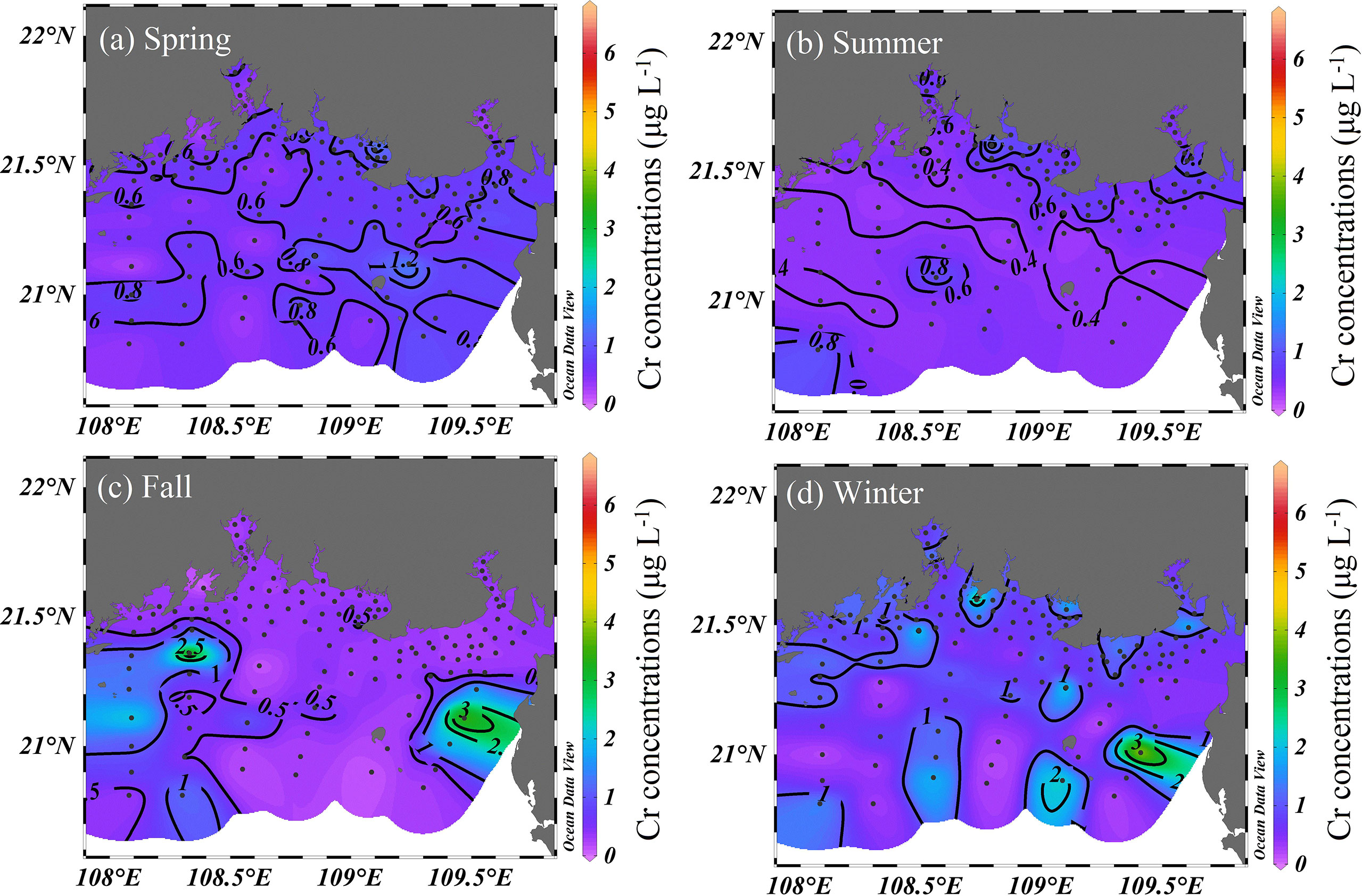
Figure 7 Spatial distributions of Cr in the surface seawater of Beibu Gulf during the sampling periods. (A) Cr-Spring; (B) Cr-Summer; (C)-Cr-Fall; (D) Cr-Winter.
The relationship between heavy metals and other physicochemical parameters
The correlation analysis between the physicochemical parameters and heavy metals were presented in Table 3. The seven heavy metals are all related to physicochemical factors. The concentrations of Cu and Hg are positively correlated with temperature but negatively correlated with DO. In addition, the concentrations of Cu are also negatively correlated with salinity and pH. The concentrations of Cr are positively correlated with DO. The concentrations of Cd and As are negatively correlated with salinity, DO, and pH. The concentrations of Cu and As are positively correlated with TSM, but the concentrations of Hg are negatively correlated with TSM. The concentrations of Pb and Zn are positively correlated with DO but negatively correlated with temperature. In addition, the concentrations of Pb are also positively correlated with salinity.
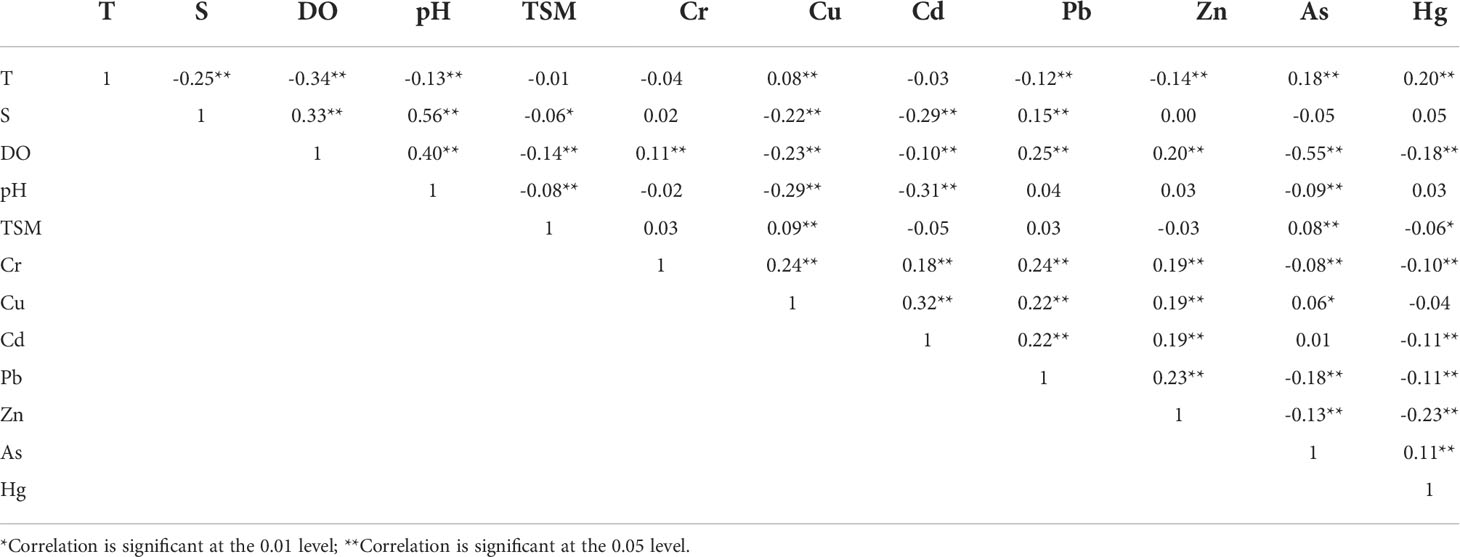
Table 3 Correlation analysis between heavy metals and other physicochemical parameters in the Beibu Gulf.
Assessment of heavy metal contamination in the seawater
The calculated potential ERI for each heavy metal and the ERI are presented in Table 6. During the whole year, the values decreased in the order of Hg > Pb > Cu > Cd > Zn > As > Cr. The contribution of Hg for ERI is 94% to be the main ecological risk factor in the Beibu Gulf, and which is similar to the previous studies on the coast of the northern Beibu Gulf (Liu et al., 2020; Lao et al., 2022a). Seasonally, the highest ERI was found in summer, followed by spring, fall, and the lowest value was found in winter (Table 4). Similarly, Hg is the main ecological risk factor during the four seasons. Moreover, the values for Hg in the four seasons were all higher than 40, and the contribution for ERI in spring, summer, fall and winter were 95%, 96%, 93% and 88%, respectively. This suggests that the higher potential ecological risk from Hg occurs in the Beibu Gulf, and the heavy metal contamination of Hg in the gulf seems to be noticeable.
Discussion
Contaminated characteristics of heavy metals in seawater of Beibu Gulf
According to the National Standard of China for Seawater Quality (NSCSQ, GB 3097-1997), the concentrations of Cr, Cu, Cd, and As in the seawater of Beibu Gulf were all lower than the Grade I of NSCSQ (Table 4), suggesting that those heavy metals in the seawater of Beibu Gulf did not suffer from serious heavy metal contaminations. However, 0.5% of Pb and 18% of Zn concentrations exceed this standard, but the concentrations of those heavy metals were lower than the Grade II of NSCSQ. In addition, 84% of Hg concentrations were higher than the Grade I of NSCSQ, and there were still 4% of Hg concentrations higher than the Grade II of NSCSQ (Table 4). This indicates that Hg is the main contaminated metal in the seawater of Beibu Gulf.
Compared with other regions, the concentrations of heavy metals in the seawater of Beibu Gulf were either lower than or comparable with those of other similar regions, except for Hg (Table 5). The concentrations of Hg were slightly lower than that in Liaodong Bay (Zhang et al., 2017), but higher than those other regions, such as 2.7 times higher than that in Jiaozhou Bay (Wang et al., 2012), 1.6 times higher than that in the Dingzi Bay and 1.3 times higher than that in the Xiangshan Bay (Zhao et al., 2018). This suggests that Hg is at a relatively high level in the seawater of Beibu Gulf. Similar to Liaodong Bay (Zhang et al., 2017), the rapid development of industry and intensive human activities could be responsible for the higher Hg contamination in the Beibu Gulf (Lao et al., 2019a; Liu et al., 2020). This is similar to the previous studies in the northern Beibu Gulf, which suggest that Hg is the main ecological risk factor in the gulf (Lao et al., 2019a; Liu et al., 2020; Lao et al., 2022a). The concentrations of Cu, Cd, and As in Beibu Gulf were generally lower than in other regions. The concentrations of Zn were lower than those in Liaodong Bay (Zhang et al., 2017), Dingzi Bay (Pan et al., 2014), Xiangshan Bay (Zhao et al., 2018), East Guangdong coastal area (Zhang et al., 2015) and Daya Bay (Qiu et al., 2005), but higher than those in Laoshan Bay (Wang et al., 2019) and Pearl River (Zhen et al., 2016). The concentrations of Cr were higher than that in Xiangshan Bay (Zhao et al., 2018), while the concentrations were lower than those in other regions. Although Zn, Cu and Cd in the seawater of coastal northern Beibu Gulf showed an increasing trend over the past two decades, the levels of those metals were still lower than in other relatively developed coastal bays (Lao et al., 2019a; Lao et al., 2022a). This may be related to the late beginning of the rapid development period of the coastal cities around the Beibu Gulf compared to the developed regions (Liu, 2020). The concentrations of Pb were comparable with Zhanjiang Bay (Zhang et al., 2018), but higher than the world average value (Gaillardet et al., 2005). Similar to the Zhanjiang Bay, Beibu Gulf is also a famous mariculture base in China, and the Pb concentrations showed an increasing trend over the past decades due to the rapid development of mariculture in the gulf (Liu et al., 2020; Lao et al., 2022a).
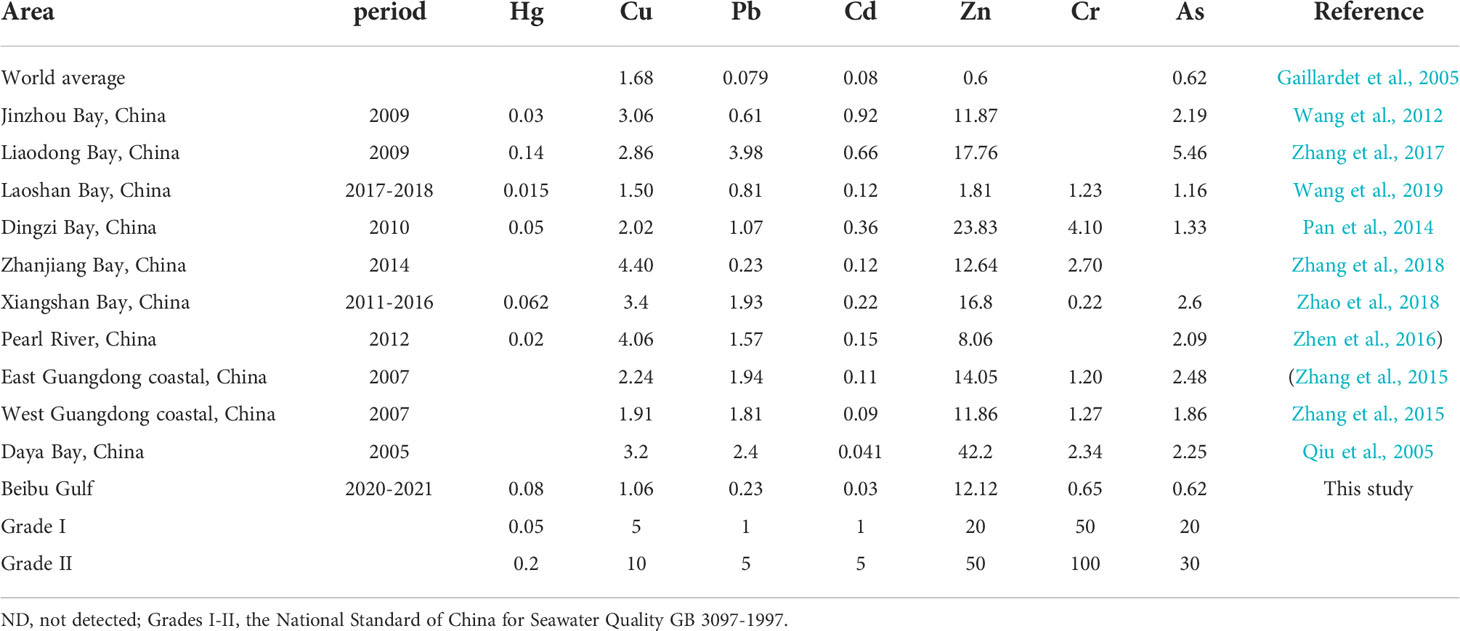
Table 5 Comparison of concentrations of heavy metals (μg L-1) in seawater of Beibu Gulf with other regions.
The biological and hydrodynamic influence on the distribution of heavy metals in the Beibu Gulf
The distribution and transport of heavy metals are greatly influenced by environmental factors and hydrological conditions (Chakraborty et al., 2016; Lao et al., 2019a; Wang et al., 2019; Lao et al., 2022a). The correlations and possible origins of heavy metals in the seawater of Beibu Gulf are further analyzed by PCA (Table 6). The values can explain 57.37% of the total heavy metals during the sampling period. In particular, PC1, PC2, PC3, and PC4 can explain 21.04%, 17.71%, 9.57%, and 9.50% of the total variance, respectively. High negative loadings for Cu, Cd, salinity, DO and pH were observed in the PC1, suggesting that those heavy metals are not only influenced by the terrestrial input but also influenced by biological activities. High positive loadings for Cr, Cu, Cd, Pb, and Zn in the PC2 indicated similar sources of those heavy metals. High positive loadings for salinity, Cr, Pb, and As were observed in the PC3, indicating that distributions of those heavy metals in the seawater of Beibu Gulf were mainly influenced by the transport of water masses with high salinity water from other areas. High negative loadings for TSM and Hg were observed in PC4, indicating the distribution of Hg was mainly influenced by the TSM in the seawater. Previous studies suggested that TSM is an important parameter that affects the distributions of dissolved heavy metals in the seawater (Feng et al., 2017; Zhang et al., 2018; Lao et al., 2019a; Lao et al., 2022a). However, the adsorption and desorption of heavy metals by particles in the seawater depend on the changes in the water environment, such as salinity, pH, and concentration of suspended particles (Lao et al., 2022a). For example, heavy metals would be more easily adsorbed onto the particles under higher salinity and TSM concentrations in the estuary areas (Feng et al., 2017), while the decrease of pH value would be more easily re-released from the particles to the seawater (Lao et al., 2022a).
Cu and Cd showed negative correlation with salinity, suggesting that those metals in the seawater of Beibu Gulf are mainly influenced by the terrestrial input. The higher concentrations of Cu and Cd were mainly observed in the coastal bays, particularly in the summer (Figures 4, 5). Previous studies have also reported that high concentrations of Cu and Cd occurred in the coastal bays and the estuary areas with low salinity in the Beibu Gulf (Lao et al., 2019a; Lao et al., 2022a). Heavy metals of Cu and Cd mainly serve as anthropogenic sources (i.e., antifouling paints, smelting and refining) (Wang et al., 2019). In the summer, fishing boats were prohibited from carrying out fishery-related activities in the SCS (about four months from 1st May). During the fishing moratorium, most of these fishing boats docked at the coastal wharf, and the fishermen began to repair and maintain the fishing boats during this period. The use of antifouling paints containing heavy metals could aggravate the contamination of those metals in the water. Moreover, the enhancement of the coastal current due to heavy rainfall during summer, the seawater of the Beibu Gulf is mainly input from the coastal current (43%) (Lao et al., 2022c), which could transport those metals from the coastal bays and the estuary areas to the offshore areas. Thus, the concentrations of Cu and Cd generally showed a decreased trend from the coastal bays to the offshore areas during summer (Figures 5F, 4B).
Similar to Cu and Cd, Cr and Zn are also mainly used in antifouling paints (Wang et al., 2019). In addition, Pb is widely used as the anti-corrosive compound for shipping and the antiknock agent in diesel fuel (Wang et al., 2018; Lao et al., 2022a). Thus, the shipping and mariculture activities mainly contributed to PC2. In addition, the distributions of Cr, Zn and Pb were similar to the Cu and Cd in summer (Figures 4B, F, 5B, F , 7B), which could also be influenced by the coastal current during this season. However, the Cu, Cd, Pb, Zn and Cr were found higher concentrations in the offshore areas during the other three seasons, suggesting that different sources and/or influent factors occurred during those periods. During the spring, fall and winter, with the decrease of the runoff in the northern gulf, the increasing intrusion of the other water masses could carry higher metals from other regions into the gulf (Lao et al., 2022c), resulting in the higher concentrations of those metals were all observed in the offshore areas. In the PC3, high positive loadings for salinity, Cr, Pb and As suggested that those metals may transport with water masses from other areas with higher salinity water. In Beibu Gulf, the higher salinity water in the west-Guangdong coastal current and SCS water are also the two dominant water masses that affect the seawater in the Beibu Gulf, and those water masses could transport a large number of materials to the gulf (Lao et al., 2022c). The proportion of SCS water to the seawater of Beibu Gulf is relatively lower in summer (30%) and fall (31%), while it changes to the dominant seawater in the gulf during winter (57%) (Lao et al., 2022c). By contrast, the contribution of the west-Guangdong coastal current is relatively stable during the whole year (24-31%) (Lao et al., 2022c). Thus, the higher concentrations of heavy metals in the offshore areas during winter may be influenced by the intrusion of SCS water and the west-Guangdong coastal current. Previous studies have reported that higher heavy metal contaminations were observed around the southern coast of Hainan Island, which likely originated from pollution discharge by intensive human activities, such as industrial discharges from port and shipping facilities, agriculture wastes, domestic sewage and frequently fishing activities (Yang et al., 2004; Li and Huang, 2012; Wang et al., 2013; Yang et al., 2019). In addition, with the rapid development of urbanization and industrialization, higher heavy metal contaminations have also been found in the Pearl River Estuary and the coastal waters of western Guangdong Province (Li et al., 2007; Zhang et al., 2010; Zhang et al., 2015; Zhang et al., 2018; Zhang et al., 2022b; Zhou et al., 2022). The higher heavy metal contamination in those regions would enter into the Beibu Gulf with the water masses, resulting in higher concentrations of heavy metals occurring in the offshore areas of the Beibu Gulf. However, in the spring and fall, the contribution of SCS water to the heavy metals loading in the Beibu Gulf should be less due to its lower contribution to the seawater of the gulf during those seasons (Lao et al., 2022c). Thus, the higher concentrations of heavy metals in the offshore area of Beibu Gulf may mainly originate from the input of the west-Guangdong coastal current during the spring and fall.
In addition, Hg in the coastal bays of the northern Beibu Gulf mainly originated from the terrestrial input (Lao et al., 2022a). The highest concentrations of Hg were observed in summer, when the coastal current was strong due to the heavy rainfall during this period, which could erode a large number of land-based pollutants into the gulf (Lao et al., 2020; Lao et al., 2021b; Chen et al., 2022b), resulting in the high concentrations of Hg appearing in the whole water of the gulf (Figure 6B). However, although the coastal current was weaker in fall than that in summer, the current in the fall is still stronger than in other seasons (Lao et al., 2022c), resulting in the higher concentrations of Hg appearing in the coastal areas in the northern Beibu Gulf (Figure 6C). By contrast, with the weakening of the coastal current in winter and spring, the contribution of the west-Guangdong coastal current and the SCS water to the Beibu Gulf increases, and the concentrations of Hg in the offshore area are higher than that in the coastal areas (Figures 6A, D). The high contaminations of Hg were also reported on the coast of western Guangdong Province and Hainan Island (Hu et al., 2013; Li et al., 2013; Wang et al., 2013; Liu et al., 2014; Zhao et al., 2020), and the metal would input into the Beibu Gulf with the transportation of the water mass. This suggests that the transportation of water masses in Beibu Gulf is greatly influenced on the distribution of Hg in the gulf.
Generally, the seasonal changes of the water masses that affect the seawater of Beibu Gulf greatly affect the distributions of heavy metals in the gulf.
Conclusion
Spatial and seasonal variations in the concentrations of the seven heavy metals were found in the seawater of Beibu Gulf. Seasonally variations in the concentrations of heavy metals were observed in the gulf, which are mainly influenced by human activities (i.e., shipping and mariculture activities) and seasonally hydrological conditions. The higher concentrations of heavy metals generally occurred in the coastal bays or areas during the summer, whereas the higher concentrations were observed in the offshore areas during the other three seasons. This is mainly related to the seasonal changes of the water masses that affect the seawater of Beibu Gulf, such as the dominant contribution of coastal current from the northern gulf in summer, and the dominant contribution of west-Guangdong coastal current from the east and SCS water from the south during the other three seasons. This study reveals that the seasonal changes of the water masses in the Beibu Gulf greatly affect the large-scale distributions of heavy metals in the Beibu Gulf, which is different from previous studies that the coastal heavy metals in the gulf are mainly affected by the northern terrigenous input, providing new insight in the impact of water masses on the distribution of metals in the gulf.
Data availability statement
The raw data supporting the conclusions of this article will be made available by the authors, without undue reservation.
Author contributions
ZZ: conceptualization, sampling, sample analysis, and writing. HW: sampling, sample analysis, and draft preparation. YG: data management and editing. LZ, PS, and QZ: conceptualization. All authors contributed to the article and approved the submitted version.
Funding
This work was supported by the National Natural Science Foundation of China (U20A20103), Guangxi Funding Project (304024XM20N0006, 2019GXNSFBA185036, 2018AD19321) and Beihai Science & Technology Project (201995037, 202082031, 202082022).
Acknowledgments
We thank all the crews on the R/V Yueke 1, R/V Yuexiayuzhi 20028 and R/V Haike 68 for the assistance with the sampling during the cruises in 2020 and 2021, and the anonymous reviewers for the revision of the manuscript.
Conflict of interest
The authors declare that the research was conducted in the absence of any commercial or financial relationships that could be construed as a potential conflict of interest.
Publisher’s note
All claims expressed in this article are solely those of the authors and do not necessarily represent those of their affiliated organizations, or those of the publisher, the editors and the reviewers. Any product that may be evaluated in this article, or claim that may be made by its manufacturer, is not guaranteed or endorsed by the publisher.
Supplementary material
The Supplementary Material for this article can be found online at: https://www.frontiersin.org/articles/10.3389/fmars.2022.996202/full#supplementary-material
References
Atkinson C. A., Jolley D. F., Simpson S. L. (2007). Effect of overlying water ph, dissolved oxygen, salinity and sediment disturbances on metal release and sequestration from metal contaminated marine sediments. Chemosphere 69 (9), 1428–1437. doi: 10.1016/j.chemosphere.2007.04.068
Cai S., Lao Q., Jin G., Chen C., Zhou X., Zhu Q., et al. (2022). Sources of nitrate in a heavily nitrogen pollution bay in beibu gulf, as identified using stable isotopes. Front. Mar. Sci. 9. doi: 10.3389/fmars.2022.956474
Chakraborty P., Chakraborty S., Jayachandran S., Madan R., Sarkar A., Linsy P., et al. (2016). Effects of bottom water dissolved oxygen variability on copper and lead fractionation in the sediments across the oxygen minimum zone, Western continental margin of India. Sci. Total. Environ. 566, 1052–1061. doi: 10.1016/j.scitotenv.2016.05.125
Chen B., He R., Cai P., Huang G., Wang F. (2022b). Geochemical speciation, risk assessment, and sources identification of heavy metals in mangrove surface sediments from the nanliu river estuary of the beibu gulf, China. Sustainability. 14 (15), 9112. doi: 10.3390/su14159112
Chen F., Huang C., Lao Q., Zhang S., Chen C., Zhou X., et al. (2021). Typhoon control of precipitation dual isotopes in southern China and its palaeoenvironmental implications. J. Geophys. Res.: Atmos. 126 (14), e2020JD034336. doi: 10.1029/2020JD034336
Chen C., Lao Q., Shen Y., Jin G., Chen F., Su Q., et al. (2022a). Comparative study of nitrogen cycling between a bay with riverine input and a bay without riverine input, inferred from stable isotopes. Front. Mar. Sci. 9, 885037. doi: 10.3389/fmars.2022.885037
Chen F., Lin J., Qian B., Wu Z., Huang P., Chen K., et al. (2018). Geochemical assessment and spatial analysis of heavy metals in the surface sediments in the eastern beibu gulf: A reflection on the industrial development of the south China coast. Int. J. Environ. Res. Public Health. 15 (3), 496. doi: 10.3390/ijerph15030496
Chen B., Xu Z., Ya H., Chen X., Xu M. (2019). Impact of the water input from the eastern qiongzhou strait to the beibu gulf on guangxi coastal circulation. Acta Oceanologica Sin. 38 (9), 1–11. doi: 10.1007/s13131-019-1472-2
Dong A., Zhai S., Zabel M., Yu Z., Zhang H., Liu F. (2012). Heavy metals in changjiang estuarine and offshore sediments: responding to human activities. Acta Oceanologica Sin. 31 (2), 88–101. doi: 10.1007/s13131-012-0195-y
Feng C., Guo X., Yin S., Tian C., Li Y., Shen Z. (2017). Heavy metal partitioning of suspended particulate matter–water and sediment–water in the Yangtze estuary. Chemosphere. 185, 717–725. doi: 10.1016/j.chemosphere.2017.07.075
Gaillardet J., Viers J., Dupre B. (2005). “Trace elements in river waters,” in Treatise on geochemistry: Surface and ground water, weathering, and soil, vol. 5 . Eds. Drever J. I., Holland H. D., Turekian K. K. (Amsterdam: Elsevier), 225–272.
Gan H., Lin J., Kai L., Zhen X. (2013). Selected trace metals (As, cd and Hg) distribution and contamination in the coastal wetland sediment of the northern beibu gulf, south China Sea. Mar. Pollut. Bull. 66, 252–258. doi: 10.1016/j.marpolbul.2012.09.020
Gu Y. G., Lin Q., Yu Z. L., Wang X. N., Ke C. L., Ning J. J. (2015). Speciation and risk of heavy metals in sediments and human health implications of heavy metals in edible nekton in beibu gulf, China: A case study of qinzhou bay. Mar. pollut. Bull. 101 (2), 852–859. doi: 10.1016/j.marpolbul.2015.11.019
Hakanson L. (1980). An ecological risk index for aquatic pollution control. A sedimentological approach. Water Res. 14 (8), 975–1001. doi: 10.1016/0043-1354(80)90143-8
Huang W., Song B., Liang J., Niu Q., Zeng G., Shen M., et al. (2021). Microplastics and associated contaminants in the aquatic environment: A review on their ecotoxicological effects, trophic transfer, and potential impacts to human health. J. Hazard. Mat. 405, 124187. doi: 10.1016/j.jhazmat.2020.124187
Hu B., Cui R., Li J., Wei H., Zhao J., Bai F., et al. (2013). Occurrence and distribution of heavy metals in surface sediments of the changhua river estuary and adjacent shelf (Hainan island). Mar. Pollut. Bull. 76 (1-2), 400–405. doi: 10.1016/j.marpolbul.2013.08.020
Hu R., Wang Y., Zhang X., Zhu L., Luo M., Liu B., et al. (2022). Sources and factors controlling the distribution of heavy metals in coastal sediments of haiyang, China. Mar. Pollut. Bull. 175, 113152. doi: 10.1016/j.marpolbul.2021.113152
Kaiser D., Schulz-Bull D. E., Waniek J. J. (2016). Profiles and inventories of organic pollutants in sediments from the central beibu gulf and its coastal mangroves. Chemosphere. 153, 39–47. doi: 10.1016/j.chemosphere.2016.03.041
Kang X., Song J., Yuan H., Duan L., Li X., Li N., et al. (2017). Speciation of heavy metals in different grain sizes of jiaozhou bay sediments: bioavailability, ecological risk assessment and source analysis on a centennial timescale. Ecotoxicol. Environ. Saf. 143, 296–306. doi: 10.1016/j.ecoenv.2017.05.036
Kumar S., Prasad S., Yadav K. K., Shrivastava M., Gupta N., Nagar S., et al. (2019). Hazardous heavy metals contamination of vegetables and food chain: Role of sustainable remediation approaches-a review. Environ. Res. 179, 108792. doi: 10.1016/j.envres.2019.108792
Lao Q., Cai S., Huang P., Chen F., Su Q., Lei X., et al. (2022a). Contaminant characteristics and influencing factors of heavy metals in seawater and sediments in a typical mariculture bay in south China. Front. Mar. Sci. 9. doi: 10.3389/fmars.2022.923494
Lao Q., Chen F., Liu G., Chen C., Jin G., Zhu Q., et al. (2019b). Isotopic evidence for the shift of nitrate sources and active biological transformation on the western coast of guangdong province, south China. Mar. Pollut. Bull. 142, 603–612. doi: 10.1016/j.marpolbul.2019.04.026
Lao Q., Liu G., Shen Y., Su Q., Gao J., Chen F. (2020). Distribution characteristics and fluxes of nutrients in the rivers of the beibu gulf. Hai Yang Xue Bao. 42 (12), 93–100. doi: 10.3969/j.issn.0253–4193.2020.12.010
Lao Q., Liu G., Shen Y., Su Q., Lei X. (2021b). Biogeochemical processes and eutrophication status of nutrients in the northern beibu gulf, south China. J. Earth System Sci. 130 (4), 1–14. doi: 10.1007/s12040-021-01706-y
Lao Q., Liu G., Zhou X., Chen F., Zhang S. (2021a). Sources of polychlorinated biphenyls (PCBs) and dichlorodiphenyltrichloroethanes (DDTs) found in surface sediment from coastal areas of beibu gulf: A reflection on shipping activities and coastal industries. Mar. Pollut. Bull. 167, 112318. doi: 10.1016/j.marpolbul.2021.112318
Lao Q., Su Q., Liu G., Shen Y., Chen F., Lei X., et al. (2019a). Spatial distribution of and historical changes in heavy metals in the surface seawater and sediments of the beibu gulf, China. Mar. Pollut. Bull. 146, 427–434. doi: 10.1016/j.marpolbul.2019.06.080
Lao Q., Wu J., Chen F., Zhou X., Li Z., Chen C., et al. (2022b). Increasing intrusion of high salinity water alters the mariculture activities in zhanjiang bay during the past two decades identified by dual water isotopes. J. Environ. Manage. 320, 115815. doi: 10.1016/j.jenvman.2022.115815
Lao Q., Zhang S., Li Z., Chen F., Zhou X., Jin G., et al. (2022c). Quantification of the seasonal intrusion of water masses and their impact on nutrients in the beibu gulf using dual water isotopes. J. Geophys. Res. Oceans. 127, e2021JC018065. doi: 10.1029/2021JC018065
Li P., Feng X., Liang P., Man Chan H., Yan H., Chen L. (2013). Mercury in the seafood and human exposure in coastal area of guangdong province, south China. Environ. Toxicol. Chem. 32 (3), 541–547. doi: 10.1002/etc.2113
Li L., Huang X. (2012). Three tropical seagrasses as potential bio-indicators to trace metals in xincun bay, hainan island, south China. Chin. J. Oceanol. Limnol. 30 (2), 212–224. doi: 10.1007/s00343-012-1092-0
Li Y., Lin Y., Wang L. (2018). Distribution of heavy metals in seafloor sediments on the East China Sea inner shelf: Seasonal variations and typhoon impact. Mar. Pollut. Bull. 129 (2), 534–544. doi: 10.1016/j.marpolbul.2017.10.027
Lin W., Feng Y., Yu K., Lan W., Wang Y., Mo Z., et al. (2020). Long-lived radionuclides in marine sediments from the beibu gulf, south China Sea: Spatial distribution, controlling factors, and proxy for transport pathway. Mar. Geol. 424, 106157. doi: 10.1016/j.margeo.2020.106157
Lin H., Lan W., Feng Q., Zhu X., Li T., Zhang R., et al. (2021). Pollution and ecological risk assessment, and source identification of heavy metals in sediment from the beibu gulf, south China Sea. Mar. Pollut. Bull. 168, 112403. doi: 10.1016/j.marpolbul.2021.112403
Liu P. (2020). Marine ecological construction and economic coordination in beibu gulf city cluster of China. J. Coast. Res. 109 (SI), 19–26. doi: 10.2112/JCR-SI109-004.1
Liu G., Lao Q., Su Q., Shen Y., Chen F., Qing S., et al. (2020). Spatial and seasonal characteristics of dissolved heavy metals in the aquaculture areas of beibu gulf, south China. Hum. Ecol. Risk Ass.: Int. J. 26 (7), 1957–1969. doi: 10.1080/10807039.2019.1629273
Liu J. L., Xu X. R., Yu S., Cheng H., Peng J. X., Hong Y. G., et al. (2014). Mercury contamination in fish and human hair from hainan island, south China Sea: implication for human exposure. Environ. Res. 135, 42–47. doi: 10.1016/j.envres.2014.08.023
Li Q., Wu Z., Chu B., Zhang N., Cai S., Fang J. (2007). Heavy metals in coastal wetland sediments of the pearl river estuary, China. Environ. Pollut. 149 (2), 158–164. doi: 10.1016/j.envpol.2007.01.006
Luo H., Lao Q., Chen F., Chen C., Zhou X., Jin G., et al. (2022). Nitrate sources and formation in aerosol and precipitation in a tropical city in south China: Insight from nitrate dual isotopes. Atmos. Environ. 278, 119087. doi: 10.1016/j.atmosenv.2022.119087
Lv J., Hu R., Wang N., Zhu L., Zhang X., Yuan X., et al. (2021). Distribution and movement of heavy metals in sediments around the coastal areas under the influence of multiple factors: A case study from the junction of the bohai Sea and the yellow Sea. Chemosphere. 278, 130352. doi: 10.1016/j.chemosphere.2021.130352
Ma X., Zuo H., Tian M., Zhang L., Meng J., Zhou X., et al. (2016). Assessment of heavy metals contamination in sediments from three adjacent regions of the yellow river using metal chemical fractions and multivariate analysis techniques. Chemosphere. 144, 264–272. doi: 10.1016/j.chemosphere.2015.08.026
Mohsen M., Lin C., Tu C., Zhang C., Xu S., Yang H. (2022). Association of heavy metals with plastics used in aquaculture. Mar. Pollut. Bull. 174, 113312. doi: 10.1016/j.marpolbul.2021.113312
Pan J., Pan J. F., Wang M. (2014). Trace elements distribution and ecological risk assessment of seawater and sediments from Dingzi Bay, Shandong Peninsula, North China. Mar. Pollut. Bull. 89, 427–434. doi: 10.1016/j.marpolbul.2014.10.022
Qiu Y. W., Yan W., Wang Z. D., Zhang G. (2005). Distributions of heavy metals in seawater, sediments and organisms at daya bay and their ecological harm. J. Trop. Oceanogr. 24, 69–76. doi: 10.1007/s10971-005-6694-y
Rainbow P. S., Luoma S. N. (2011). Metal toxicity, uptake and bioaccumulation in aquatic invertebrates–modelling zinc in crustaceans. Aquat. Toxicol. 105 (3-4), 455–465. doi: 10.1016/j.aquatox.2011.08.001
Wang J., Liu R. H., Yu P., Tang A. K., Xu L. Q., Wang J. Y. (2012). Study on the pollution characteristics of heavy metals in seawater of jinzhou bay. Proc. Environ. Sci. 13, 1507–1516. doi: 10.1016/j.proenv.2012.01.143
Wang X., Liu L., Zhao L., Xu H., Zhang X. (2019). Assessment of dissolved heavy metals in the laoshan bay, China. Mar. Pollut. Bull. 149, 110608. doi: 10.1016/j.marpolbul.2019.110608
Wang S. L., Xu X. R., Sun Y. X., Liu J. L., Li H. B. (2013). Heavy metal pollution in coastal areas of south China: A review. Mar. Pollut. Bull. 76 (1-2), 7–15. doi: 10.1016/j.marpolbul.2013.08.025
Wang X., Zhao L., Xu H., Zhang X. (2018). Spatial and seasonal characteristics of dissolved heavy metals in the surface seawater of the yellow river estuary, China. Mar. Poll. Bull. 137, 465–473. doi: 10.1016/j.marpolbul.2018.10.052
Xia P., Meng X., Yin P., Cao Z., Wang X. (2011). Eighty-year sedimentary record of heavy metal inputs in the intertidal sediments from the nanliu river estuary, beibu gulf of south China Sea. Environ. Pollut. 159 (1), 92–99. doi: 10.1016/j.envpol.2010.09.014
Xu C., Dan S. F., Yang B., Lu D., Kang Z., Huang H., et al. (2021). Biogeochemistry of dissolved and particulate phosphorus speciation in the maowei Sea, northern beibu gulf. J. Hydrol. 593, 125822. doi: 10.1016/j.jhydrol.2020.125822
Xu C., Yang B., Dan S. F., Zhang D., Liao R., Lu D., et al. (2020). Spatiotemporal variations of biogenic elements and sources of sedimentary organic matter in the largest oyster mariculture bay (Maowei Sea), southwest China. Sci. Total. Environ. 730, 139056. doi: 10.1016/j.scitotenv.2020.139056
Yang T., Cheng H., Wang H., Drews M., Li S., Huang W., et al. (2019). Comparative study of polycyclic aromatic hydrocarbons (PAHs) and heavy metals (HMs) in corals, surrounding sediments and surface water at the dazhou island, China. Chemosphere. 218, 157–168. doi: 10.1016/j.chemosphere.2018.11.063
Yang J. H., Jiang S. Y., Wang X. R., Wang Y. (2004). Heavy metals in coastal waters from sanya bay, hainan island: implication for human impact on the estuarine coastal environments. J. Coast. Res. 43, 171–178.
Yang G., Sun X., Song Z. (2020). Trophic level and heavy metal pollution of sardinella albella in liusha bay, beibu gulf of the south China Sea. Mar. Pollut. Bull. 156, 111204. doi: 10.1016/j.marpolbul.2020.111204
Yang J., Wang W., Zhao M., Chen B., Dada O. A., Chu Z. (2015). Spatial distribution and historical trends of heavy metals in the sediments of petroleum producing regions of the beibu gulf, China. Mar. Pollut. Bull. 91 (1), 87–95. doi: 10.1016/j.marpolbul.2014.12.023
Zhang H., Cui B., Xiao R., Zhao H. (2010). Heavy metals in water, soils and plants in riparian wetlands in the pearl river estuary, south China. Proc. Environ. Sci. 2, 1344–1354. doi: 10.1016/j.proenv.2010.10.145
Zhang Z., Hu B., Qiu H. (2021a). Comprehensive assessment of ecological risk in southwest guangxi-beibu bay based on DPSIR model and OWA-GIS. Ecol. Indic. 132, 108334. doi: 10.1016/j.ecolind.2021.108334
Zhang L., Lu L., Zhu W., Yang B., Zhang S. (2021b). Organophosphorus flame retardants (opfrs) in the seawater and sediments of the qinzhou bay, northern beibu gulf: occurrence, distribution, and ecological risks. Mar. Pollut. Bull. 168, 112368. doi: 10.1016/j.marpolbul.2021.112368
Zhang L., Meng L., Wang H., Lu D., Luo X. (2022a). Development and validation of a liquid chromatography-tandem mass spectrometry method for comprehensive detection of organophosphate esters and their degradation products in sediment. J. Chromatogr. A 1665, 462826. doi: 10.1016/j.chroma.2022.462826
Zhang L., Ni Z., Li J., Shang B., Wu Y., Lin J., et al. (2022b). Characteristics of nutrients and heavy metals and potential influence of their benthic fluxes in the pearl river estuary, south China. Mar. Pollut. Bull. 179, 113685. doi: 10.1016/j.marpolbul.2022.113685
Zhang L., Shi Z., Zhang J., Jiang Z., Wang F., Huang X. (2015). Spatial and seasonal characteristics of dissolved heavy metals in the east and west guangdong coastal waters, south China. Mar. Pollut. Bull. 95 (1), 419–426. doi: 10.1016/j.marpolbul.2015.03.035
Zhang A., Wang L., Zhao S., Yang X., Zhao Q., Zhang X., et al. (2017). Heavy metals in seawater and sediments from the northern liaodong bay of China: Levels, distribution and potential risks. Regional Stud. Mar. Sci. 11, 32–42. doi: 10.1016/j.rsma.2017.02.002
Zhang J., Zhou F., Chen C., Sun X., Shi Y., Zhao H., et al. (2018). Spatial distribution and correlation characteristics of heavy metals in the seawater, suspended particulate matter and sediments in zhanjiang bay, China. PloS One. 13 (8), e0201414. doi: 10.1371/journal.pone.0201414
Zhao L., Liu J., Cai G., Huang L., Luo W. (2020). Distribution, source, and pollution assessment of heavy metals in sanya offshore area, south hainan island of China. Mar. Pollut. Bull. 160, 111561. doi: 10.1016/j.marpolbul.2020.111561
Zhao B., Wang X., Jin H., Feng H., Shen G., Cao Y., et al. (2018). Spatiotemporal variation and potential risks of seven heavy metals in seawater, sediment, and seafood in xiangshan bay, chin –2016). Chemosphere. 212, 1163–1171. doi: 10.1016/j.chemosphere.2018.09.020
Zhen G., Li Y., Tong Y., Yang L., Zhu Y., Zhang W. (2016). Temporal variation and regional transfer of heavy metals in the pearl (Zhujiang) river, China. Environ. Sci. Pollut. Res. 23 (9), 8410–8420. doi: 10.1007/s11356-016-6077-7
Zhou F., Xiong M., Wang S., Tian S., Jin G., Chen F., et al. (2022). Impacts of human activities and environmental changes on spatial-seasonal variations of metals in surface sediments of zhanjiang bay, China. Front. Mar. Sci. 9. doi: 10.3389/fmars.2022.925567
Zhu Z., Wei H., Huang W., Wu X., Guan Y., Zhang Q. (2021). Occurrence of microplastic pollution in the beibu gulf, the northern of south China Sea. Front. Mar. Sci. 8, 821008. doi: 10.3389/fmars.2021.821008
Zhu Z., Zheng A. (2013). Distributions and sources of heavy metals in seawater of the northern beibu gulf. Advanced Mat. Res. 807-809, 7–13. doi: 10.4028/www.scientific.net/AMR.807-809.7
Zhu Z., Zheng A. (2017a). Determination of rhenium in seawater from the jiulong river estuary and Taiwan strait, China by automated flow injection inductively coupled plasma-mass spectrometry. Analytical Lett. 50 (9), 1422–1434. doi: 10.1080/00032719.2016.1233244
Zhu Z., Zheng A. (2017b). Automated flow injection coupled with ICP-MS for the online determination of trace silver in seawater. Spectroscopy. 32, 50–59.
Keywords: heavy metals, seasonal and spatial variation, water mass, ecological risk assessment, Beibu Gulf
Citation: Zhu Z, Wei H, Guan Y, Zhang L, Sun P and Zhang Q (2022) Spatial and seasonal characteristics of dissolved heavy metals in the seawater of Beibu Gulf, the Northern South China Sea. Front. Mar. Sci. 9:996202. doi: 10.3389/fmars.2022.996202
Received: 17 July 2022; Accepted: 07 September 2022;
Published: 23 September 2022.
Edited by:
Peng Lin, Texas A&M University at Galveston, United StatesReviewed by:
Ruifeng Zhang, Shanghai Jiao Tong University, ChinaFengxia Zhou, Guangdong Ocean University, China
Copyright © 2022 Zhu, Wei, Guan, Zhang, Sun and Zhang. This is an open-access article distributed under the terms of the Creative Commons Attribution License (CC BY). The use, distribution or reproduction in other forums is permitted, provided the original author(s) and the copyright owner(s) are credited and that the original publication in this journal is cited, in accordance with accepted academic practice. No use, distribution or reproduction is permitted which does not comply with these terms.
*Correspondence: Zuhao Zhu, emh1enVoYW9ANGlvLm9yZy5jbg==
 Zuhao Zhu
Zuhao Zhu Huihua Wei
Huihua Wei Yao Guan
Yao Guan Li Zhang
Li Zhang Pengfei Sun
Pengfei Sun Qiufeng Zhang2
Qiufeng Zhang2

